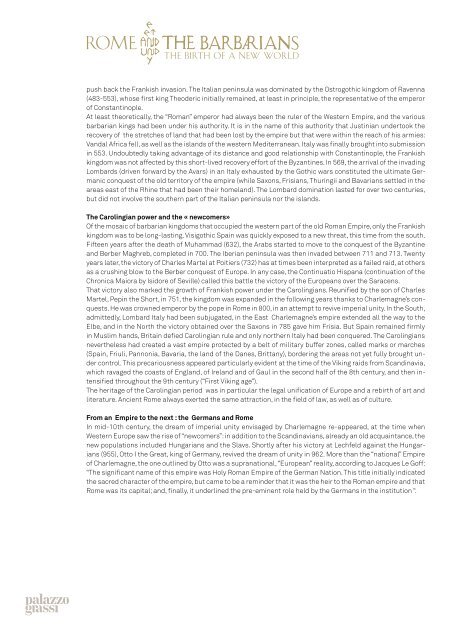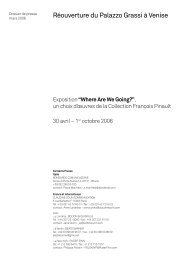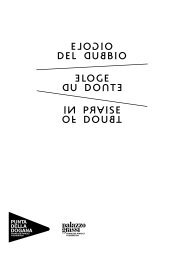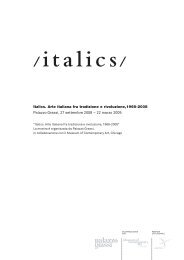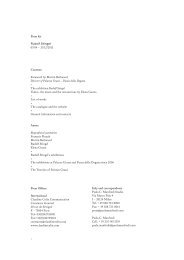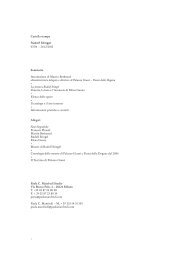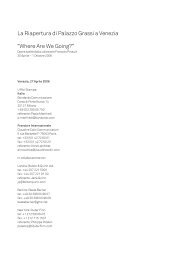pdf file, 819 Kb - Palazzo Grassi
pdf file, 819 Kb - Palazzo Grassi
pdf file, 819 Kb - Palazzo Grassi
You also want an ePaper? Increase the reach of your titles
YUMPU automatically turns print PDFs into web optimized ePapers that Google loves.
push back the Frankish invasion. The Italian peninsula was dominated by the Ostrogothic kingdom of Ravenna<br />
(483-553), whose first king Theoderic initially remained, at least in principle, the representative of the emperor<br />
of Constantinople.<br />
At least theoretically, the “Roman” emperor had always been the ruler of the Western Empire, and the various<br />
barbarian kings had been under his authority. It is in the name of this authority that Justinian undertook the<br />
recovery of the stretches of land that had been lost by the empire but that were within the reach of his armies:<br />
Vandal Africa fell, as well as the islands of the western Mediterranean. Italy was finally brought into submission<br />
in 553. Undoubtedly taking advantage of its distance and good relationship with Constantinople, the Frankish<br />
kingdom was not affected by this short-lived recovery effort of the Byzantines. In 569, the arrival of the invading<br />
Lombards (driven forward by the Avars) in an Italy exhausted by the Gothic wars constituted the ultimate Germanic<br />
conquest of the old territory of the empire (while Saxons, Frisians, Thuringii and Bavarians settled in the<br />
areas east of the Rhine that had been their homeland). The Lombard domination lasted for over two centuries,<br />
but did not involve the southern part of the Italian peninsula nor the islands.<br />
The Carolingian power and the « newcomers»<br />
Of the mosaic of barbarian kingdoms that occupied the western part of the old Roman Empire, only the Frankish<br />
kingdom was to be long-lasting. Visigothic Spain was quickly exposed to a new threat, this time from the south.<br />
Fifteen years after the death of Muhammad (632), the Arabs started to move to the conquest of the Byzantine<br />
and Berber Maghreb, completed in 700. The Iberian peninsula was then invaded between 711 and 713. Twenty<br />
years later, the victory of Charles Martel at Poitiers (732) has at times been interpreted as a failed raid, at others<br />
as a crushing blow to the Berber conquest of Europe. In any case, the Continuatio Hispana (continuation of the<br />
Chronica Maiora by Isidore of Seville) called this battle the victory of the Europeans over the Saracens.<br />
That victory also marked the growth of Frankish power under the Carolingians. Reunified by the son of Charles<br />
Martel, Pepin the Short, in 751, the kingdom was expanded in the following years thanks to Charlemagne’s conquests.<br />
He was crowned emperor by the pope in Rome in 800, in an attempt to revive imperial unity. In the South,<br />
admittedly, Lombard Italy had been subjugated, in the East Charlemagne’s empire extended all the way to the<br />
Elbe, and in the North the victory obtained over the Saxons in 785 gave him Frisia. But Spain remained firmly<br />
in Muslim hands, Britain defied Carolingian rule and only northern Italy had been conquered. The Carolingians<br />
nevertheless had created a vast empire protected by a belt of military buffer zones, called marks or marches<br />
(Spain, Friuli, Pannonia, Bavaria, the land of the Danes, Brittany), bordering the areas not yet fully brought under<br />
control. This precariousness appeared particularly evident at the time of the Viking raids from Scandinavia,<br />
which ravaged the coasts of England, of Ireland and of Gaul in the second half of the 8th century, and then intensified<br />
throughout the 9th century (“First Viking age”).<br />
The heritage of the Carolingian period was in particular the legal unification of Europe and a rebirth of art and<br />
literature. Ancient Rome always exerted the same attraction, in the field of law, as well as of culture.<br />
From an Empire to the next : the Germans and Rome<br />
In mid-10th century, the dream of imperial unity envisaged by Charlemagne re-appeared, at the time when<br />
Western Europe saw the rise of “newcomers”: in addition to the Scandinavians, already an old acquaintance, the<br />
new populations included Hungarians and the Slavs. Shortly after his victory at Lechfeld against the Hungarians<br />
(955), Otto I the Great, king of Germany, revived the dream of unity in 962. More than the “national” Empire<br />
of Charlemagne, the one outlined by Otto was a supranational, “European” reality, according to Jacques Le Goff:<br />
“The significant name of this empire was Holy Roman Empire of the German Nation. This title initially indicated<br />
the sacred character of the empire, but came to be a reminder that it was the heir to the Roman empire and that<br />
Rome was its capital; and, finally, it underlined the pre-eminent role held by the Germans in the institution “.


